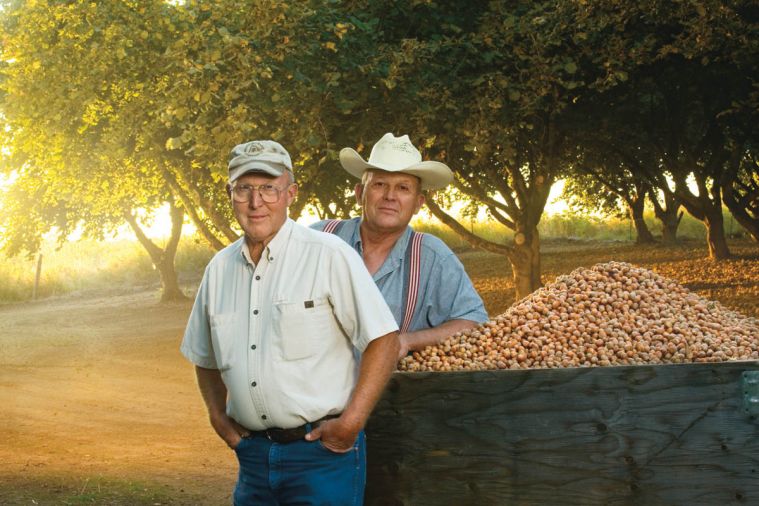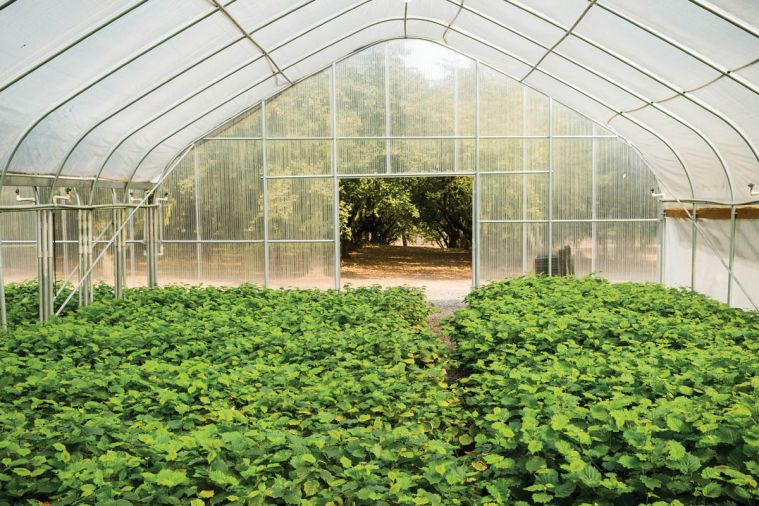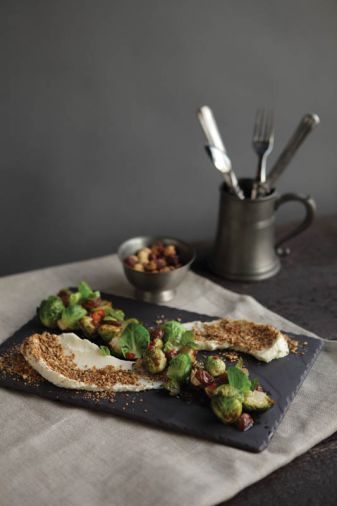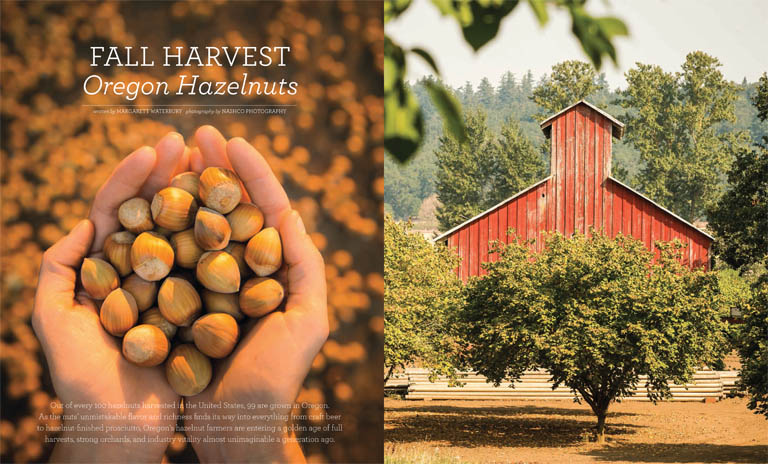It is 6 a.m. on a cool, foggy morning in early October. Tom Roger, Hazelnut Manager for Columbia Empire Farms, is already at work. A 38-year veteran of the industry, Roger manages a growing 255 acres of hazelnut orchard in Sherwood, Oregon, at the northeast edge of the famously fertile Willamette Valley. He and his team will be there until 1 a.m. that night, sweeping, collecting, hulling, and processing Oregon’s most famous nut, foot soldiers in the state’s campaign to become the world’s greatest growing region for Corylus avellana.
Oregon’s hazelnut industry is thriving. This year’s crop is estimated to be about 40,000 tons of hazelnuts, an 8-10% increase over last year. Michael Klein, Executive Director of the Oregon Hazelnut Industry Office, thinks the next few years will bring an even more dramatic increase. Though Oregon comprises just five to seven percent of the global market, which is dominated by Turkey, the state is internationally recognized for growing the plumpest, sweetest, and most delicious hazelnuts in the world.
But it wasn’t always this way. Not long ago, a disease called Eastern Filbert Blight threatened the very existence of this iconic Oregon industry. A fungal disease that first appeared in the Pacific Northwest in 1973, Eastern Filbert Blight is a slow-moving – but lethal – infection with no known treatment. “You can prune, or you can spray to try and slow it down, but there’s no silver bullet to get rid of Eastern Filbert Blight,” says Roger. “You’re just waiting for your trees to die.”
The discovery of Eastern Filbert Blight shook the Northwest farming community. “The mood was very somber,” says Klein. “More than one grower commented that they remember the day they found Eastern Filbert Blight in their orchard more clearly than any other life event. It was that big of a shock.”
Dead and dying trees were torn out to make way for grapes, grass seed, and other crops, while long-time hazelnut farmers mourned what appeared to be the imminent loss of their livelihoods. Klein describes how “many of the older growers simply gave up as the disease spread, then pushed their trees out or abandoned orchards. Their children had little reason to consider staying in farming and looked for other careers, as there was little hope that things would turn around. Our industry meetings and gatherings had few young farmers, if any.”
Fortunately, plant breeders at Oregon State University in Corvallis took notice, and began to develop varieties like Jefferson and Yamhill bred to resist Eastern Filbert Blight. Hazelnuts are long-lived and slow-growing (some orchards in the Willamette Valley are more than 100 years old), and it takes five to seven years for a sapling to grow into a nut-producing tree. Those plantings of blight-resistant hazelnuts are just now starting to bear fruit, just in time to meet exploding global demand – and record high prices – for Oregon hazelnuts.
When asked what it’s like to be a grower today, the pleasure in Roger’s voice is almost palpable. “It’s exciting! We have all these new varieties to plant, and demand’s growing faster than we can grow. After watching everything decline because of the blight, now we can expand out and replant with varieties that aren’t going to die on us. We might have some growing pains, but I think we’re going to come out better on the other side.”
He has good reason for optimism. U.S. consumers are starting to realize just how delicious – and versatile – hazelnuts can be. “Anybody who graduated from college in the last five years knows what Nutella is,” says Klein. “But when they get out of college, they know they can’t just sit with a jar and a spoon, so they’re looking for other ways to eat hazelnuts.” While the buttery nuts are a natural pairing with chocolate, they also provide fantastic texture, richness, and flavor in savory dishes. “At certain times of the year, when they’re at their peak, they pair with almost everything,” says Aaron Barnett, Chef at Portland’s St. Jack and La Moule restaurants
“I love a beurre noisette sauce made with brown butter, lemon, herbs, and hazelnuts with fish, and they’re delicious with pork.”
When cooking with hazelnuts, many chefs take inspiration from other areas with strong hazelnut growing traditions like France, Italy, and Turkey, all of which are connected to the Willamette Valley by the 45th parallel. That latitude is characterized by relatively mild temperatures and regular precipitation, exactly the right conditions for hazelnuts (and many other wonderful crops, like wine grapes, fruit trees, berries, and barley) to thrive. Here in Oregon, the Willamette Valley’s rich volcanic and glacial soils also provide ideal fertility for hazelnuts, and most established plants don’t need any irrigation at all. “We’ve got the right temperature, we’ve got the right soil types, and we’ve got the right amount of rainfall falling at the right time,” explains Klein.
Unlike most other tree fruits, which are picked off the branch, hazelnuts are harvested only after they fall to the ground. Nuts begin dropping in late summer and continue falling as late as mid-October, depending on the weather. Large plow-like machines called sweepers maneuver the fallen nuts into windrows, long, heaping mounds running lengthwise through the spaces between trees. A machine called a harvester then travels over each windrow, separating the nuts from any twigs and leaves before collecting them in totes for later processing.
Once those nuts are collected, they still need to be dried, processed, packaged, and distributed. Most farmers rely on third-party processors for those services, but some, like Columbia Empire, are more vertically integrated. “We do all our processing on site,” explains Roger. “Washing, drying, cracking, sorting, and processing, clear to the end. We even put some hazelnuts into candy we make ourselves.”
As demand for hazelnuts climbs around the world, the Willamette Valley has become a locus for that growth. We export many of our nuts to international markets, including Italy, where they end up in gianduja, that delectable combination of hazelnut and chocolate. They also make their way to China, where snackers enjoy hazelnuts after they’re brined, roasted in the shell, and then slightly cracked, much like a peanut or sunflower seed.
Oregon’s hazelnut market has staged a remarkable recovery. Today, 45,000 acres of the Willamette Valley are planted with hazelnuts, up from just 30,000 acres five years ago. “It’s turned around completely,” says Klein. “A lot of young farmers coming out of ag schools are taking over the farms from their parents, or grandparents. Our meetings still have the older growers, but have lots of young farmers too.” Grass seed growers are starting to convert pasture to orchard, and California’s beleaguered nut growers are eyeing expansion opportunities in comparatively water-rich Oregon.
Roger’s attitude towards those new entrants is a welcoming one, a testament to Oregonians’ resilience even after challenging times. “There are some farm industries that do not share anything. But we’re not like that. We’re pretty willing to help out and be open within the industry, even with brand new people coming in. The bigger we can get our industry, the bigger share of the market we hold. We don’t want anybody to not be a success,” Roger muses, eye on the long game. “We just want more nuts out there.”
Hazelnut Brown Butter Torte with Honey-Camomile Cream and "Honeycomb" Candy
HAZELNUT-BROWN BUTTER TORTE
- 5 ounces (1 ¼ cups) Roasted hazelnuts
- ½ pounds (1 cup) plus 1 T Unsalted butter
- ½ Vanilla bean, seeds scraped
- 1 1/3 cups Powdered sugar
- 1/3 cups Almond flour
- 5 large Egg whites
- 3 T Granulated sugar
- 1 tsp Kosher salt
- Honey-Chamomile Ice Cream, for serving (recipe follows)
- “Honeycomb” Candy, for serving (recipe follows)
- Extra-virgin olive oil, for serving
- Seasonal berries or figs, for serving (optional)
Preheat the oven to 350º. In a food processor, add the nuts and powdered sugar; process until finely ground.
To brown the butter, place the butter in a small pot over medium heat. Place the vanilla bean pod and the scraped seeds in with the butter and swirl the butter until melted. Turn the heat down to low and continue to cook, being careful, as the butter will spatter a bit as the water in it evaporates. Cook the butter until the milk solids have turned toasty and golden brown, about ten minutes. The butter will foam up as it gets close, and it will be difficult to see how browned the milk solids have gotten. When the butter starts to smell delicious and nutty, remove it from the heat just long enough for the foaming to subside and you can see into the bottom of the pot. If the butter smells nutty and is a deep golden brown, remove from the heat. Cool for about ten minutes before incorporating into the other ingredients. Remove the vanilla pod and discard.
In a large bowl or the bowl of a stand mixer, whisk the egg whites until stiff peaks form. Working in three batches, alternate adding the dry ingredients and brown butter into the egg whites.
Brush the bottom of a 10” round spring-form cake pan (or a 10” square cake pan) with one tablespoon of the vanilla brown butter. Pour in the batter.
Bake until a toothpick poked into the center of the cake comes out clean, 45 to 60 minutes. Remove then let cool on a baking rack for 30 minutes before releasing from the pan.
Serve the cake slightly warm with a scoop of honey-chamomile ice cream and crumbled honeycomb candy. Garnish with a drizzle of extra virgin olive oil and some seasonal fruit, if you like.
HONEY-CHAMOMILE ICE CREAM
Makes about 5 cups
- 1 ½ cups Heavy cream
- 1 cup Milk
- ¼ cup Honey
- 1/3 cup Dried chamomile flowers
- 6 large Egg yolks
- 3 T Granulated sugar
- ¼ tsp Kosher salt
In a medium pot, add the cream, milk and honey; bring to a simmer over medium heat, then remove from the heat. Add the chamomile flowers and let steep ten minutes; strain.
In a medium bowl, add the yolks, sugar and salt; whisk to combine. Slowly pour the cream mixture into the yolk mixture, whisking constantly.
Transfer the ice cream base to a heavy-bottomed, stainless steel pot and cook over low heat, stirring constantly with a heatproof rubber spatula. As soon as it thickens (and before the eggs scramble), strain through a fine-mesh strainer. Chill to cool completely before transferring to an ice cream machine; spin according to the manufacturer’s directions.
“HONEYCOMB” CANDY
Makes about 8 to 10 servings
- Vegetable oil, for greasing the pan
- 1 ½ cups Granulated sugar
- ¼ cup Honey
- 1 T Baking soda
Rub or spray a baking sheet or silicone baking mat with vegetable oil. In a large, heavy-bottomed, stainless steel pot, add the sugar, honey and ¼ cup water; heat over medium-high until the mixture registers 300º on a candy thermometer. Immediately remove from the heat and whisk in the baking soda, then quickly pour the mixture onto the prepared sheet pan, but do not smash it down or you will lose the air pockets that make this candy so light and crispy. Let cool to room temperature for about fifteen minutes, then break off shards of the candy, crumbling some and leaving others in larger pieces.
Ox Restaurant's Roasted Brussel Sprouts with Hazelnut Dukkah
- 1 pound Brussels sprouts, cleaned and cut in half
- 2 T Extra virgin olive oil
- Sea salt, to taste
- Freshly ground black pepper, to taste
- 1 cup Spicy Golden Raisin Vinaigrette (recipe below)
- 1 cup Mascarpone
- 3/4 cup Hazelnut Dukkah (recipe below)
- 1 Fresno chile, very thinly sliced
- Fresh mint chiffonade
Preheat oven to 400ºF. Place the Brussels sprouts, olive oil, sea salt and black pepper in a large bowl and toss gently to combine. Spread them out on a rimmed baking sheet and roast in the oven until lightly browned on the outside and just tender, 35 to 40 minutes. Remove from the oven and place the Brussels sprouts back into a large bowl with the spicy golden raisin vinaigrette and ¼ cup of the hazelnut dukkah. Toss together and adjust seasoning if necessary.
To plate: Spread the mascarpone over the bottom of 4 small flat plates. Sprinkle the remaining hazelnut dukkah onto the mascarpone. Divide the Brussels sprouts among the 4 plates. Garnish with the mint chiffonade and the fresno chile slices.
HAZELNUT DUKKAH
- 1 cup Roasted hazelnuts
- ½ cup Toasted sesame seed
- ¼ cup Sunflower seed
- 2 T Coriander seed
- 1 T Cumin seed
Chop the hazelnuts very finely, or pulse in the food processor until they are uniformly small but not to the point where it becomes a powder or paste. Add the sesame seeds. Roast the sunflower seeds and pulse in food processor until lightly broken up. Combine with hazelnuts and sesame.
Toast each of the spices (separately) in a small pan over medium heat, until they are fragrant. Combine the three spices in a spice grinder and pulse until chopped up but not a homogenous powder. Place in the same bowl and add the salt and pepper. Mix very well to combine. Keep refrigerated.
SPICY GOLDEN-RAISIN VINAIGRETTE
- 2 T Extra-virgin olive oil
- 2 tsp Freshly chopped garlic
- ¼ tsp Red chili flakes
- ¼ cup Rice vinegar
- 2 T cup Soy sauce (gluten-free if desired)
- ½ cup Golden raisins
- 3/4 tsp Kosher salt
In a medium stainless steel pot over medium heat, add the olive oil, chopped garlic and chili flakes. Cook, stirring often, until the garlic is golden brown and smells toasty, about 4 minutes. Add the rice vinegar, soy sauce, raisins and salt. Remove from the heat and adjust the seasoning if necessary.
St. Jack Restaurant Paris- Brest of Hazelnut Praline and Brown Butter Creme Patisserie
PATE A CHOUX
- ½ cup (1 stick) Unsalted butter, cut into 1/2-inch pieces
- 1 tsp Sugar
- ½ tsp Salt
- 1 ¼ cups All-purpose flour
- 4 large Eggs, plus 1 large egg white
- Bring butter, sugar, salt and 1 cup water to a boil in a medium saucepan. Remove from heat. Using a wooden spoon, quickly stir in flour. Cook over medium-high heat, stirring constantly, until mixture pulls away from sides and a film forms on bottom of pan, about 3 minutes.
- Transfer to the bowl of an electric mixer with the paddle attachment. Mix on low speed until slightly cooled, about 1 minute. Raise speed to medium; add whole eggs, 1 at a time, until a soft peak forms when batter is touched with your finger. If peak does not form, lightly beat remaining egg white, and mix it into batter a little at a time until it does.
- Pipe into two circles on a price of greased parchment. Bake at 350 until puffed and golden brown. Approximately 5 minutes.
HAZELNUT PRALINE
In a heavy bottomed sauté pan melt 2 cups of sugar and cook until a rich golden brown Add 1 cup of hazelnuts. Mix and allow to cool on a greased baking sheet. Once cool roughly chop it and set aside.
CREME PATISSERIE
- 1 cup Milk combined with 2T browned butter
- 3 large Egg yolks
- 3 T Sugar
- 3 T All-purpose flour
- 1 tsp Pure vanilla extract
- 1 cup Cream whipped to stiff peaks
- In a small saucepan, bring the milk and brown butter to a boil over medium heat. In a separate bowl, whisk egg yolks and sugar together in a small bowl. Add flour, and mix until smooth.
- Thin egg-yolk mixture with approximately ¼ cup of warm milk. When remaining milk begins to boil, add it to egg-yolk mixture, and stir well. Return to saucepan, and place over high heat. Cook, whisking constantly, until pastry cream thickens and boils, about 1 minute.
- Reduce heat to medium, and cook, whisking constantly, until cream becomes shiny and easier to stir, about 2 minutes more. Pour into a bowl, and stir in vanilla and allow to cool.
- Once cool, fold into the whipped cream and chill. Once chilled, gently fold in 3/4 of the praline and put in a pastry bag.
TO ASSEMBLE
Cut the circle of pate a choux into two layers as you would cutting layers into a cake.
Pipe the patisserie around the circle in layers until it’s about 3 inches high. Place the top on and pipe more patisserie as desired, sprinkle with the remaining praline and dust with powdered sugar.
Rack of Pork with Hazelnuts, Dijon, Cognac and Tarragon from St. Jack Restaurant
- 1 each Double cut pork chop (approx 1#)
- 2 tsp Garlic (minced)
- 2 T Shallots (minced)
- 4 T Chopped hazelnuts
- 2 T Dijon
- 2 oz Cognac
- ¼ cup Chicken stock
- ¼ cup Heavy cream
- 1 T butter
- 1 tsp Tarragon (chopped)
- 1 tsp Parsley (chopped)
- Squish of lemon
- Salt and pepper to taste
Directions:
Preheat a heavy bottomed pan over high heat.
Season pork on all sides and sear in the pan with a bit of oil.
Place in the oven and let roast to an internal temp of approximately 150º. Remove from oven and allow to rest.
In the same pan, add garlic, shallots and hazelnuts. Sauté approximately 1 minute. Add Dijon and cognac. Let flame and add stock, cream and butter and allow to reduce to sauce consistency. Finish with salt and pepper, a squish of lemon and the fresh herbs.

































